Unit 3 The world meets China Starting out 课件(共22张,内嵌视频) 2024-2025学年高二英语外研版(2019)选择性必修4
文档属性
| 名称 | Unit 3 The world meets China Starting out 课件(共22张,内嵌视频) 2024-2025学年高二英语外研版(2019)选择性必修4 | 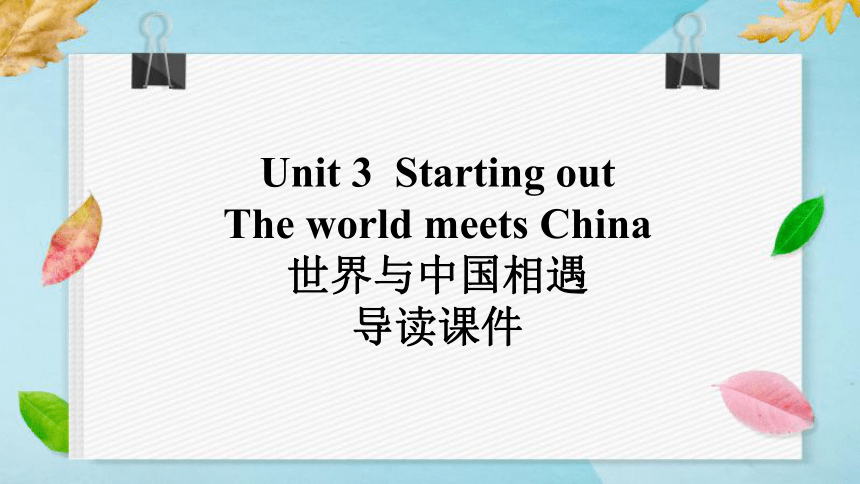 | |
| 格式 | pptx | ||
| 文件大小 | 21.2MB | ||
| 资源类型 | 教案 | ||
| 版本资源 | 外研版(2019) | ||
| 科目 | 英语 | ||
| 更新时间 | 2025-04-23 16:32:30 | ||
图片预览

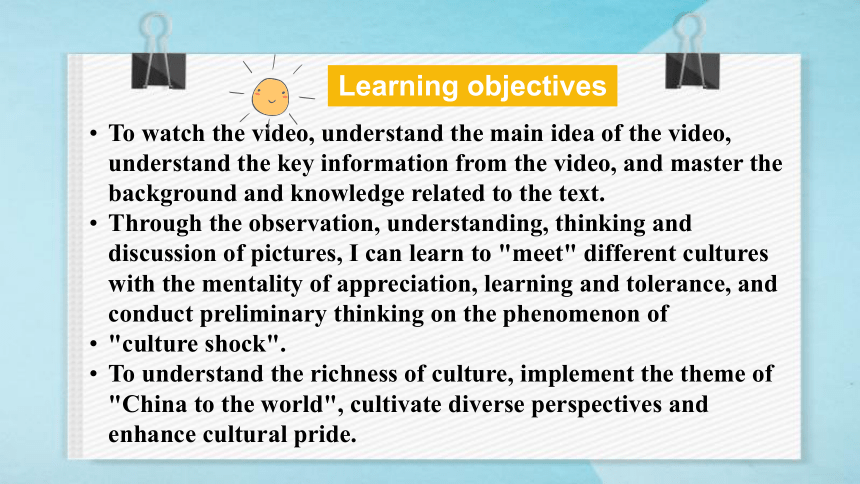
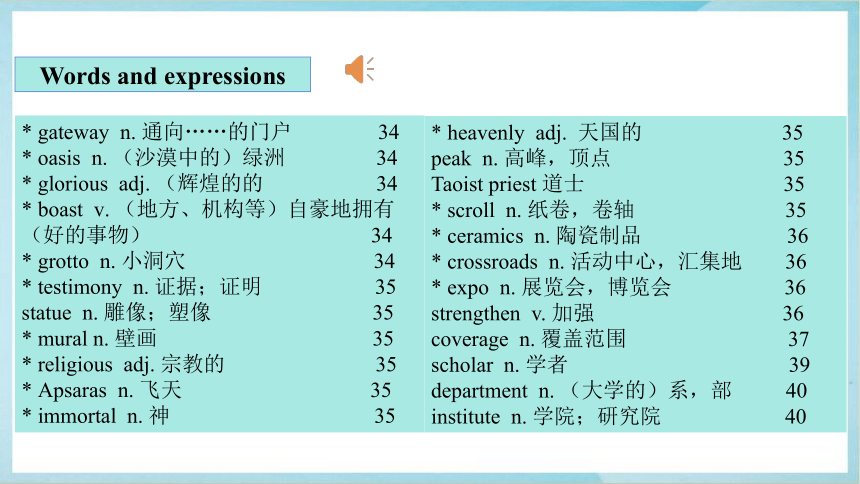
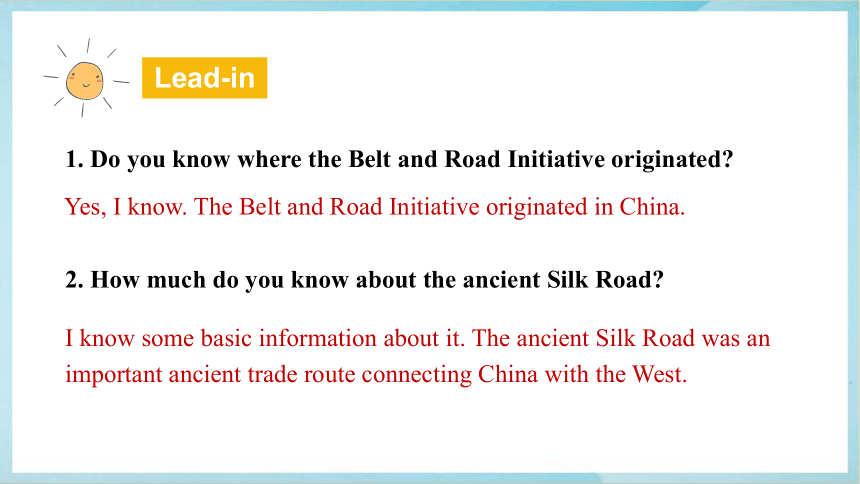
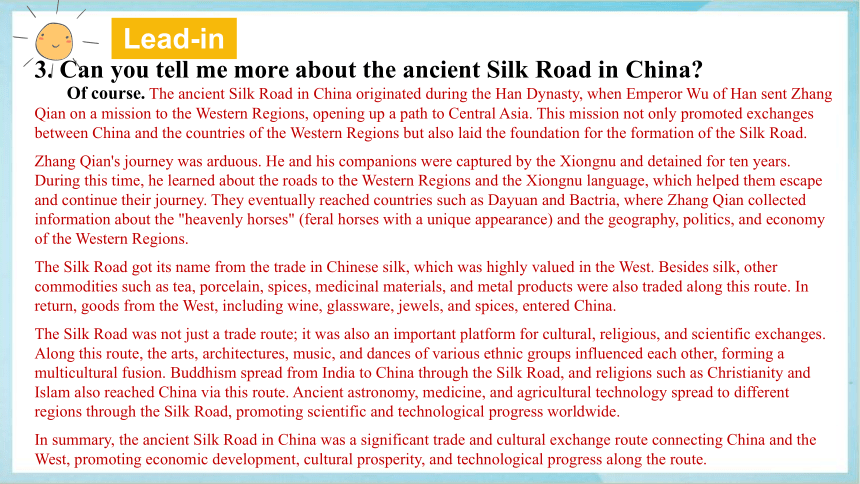
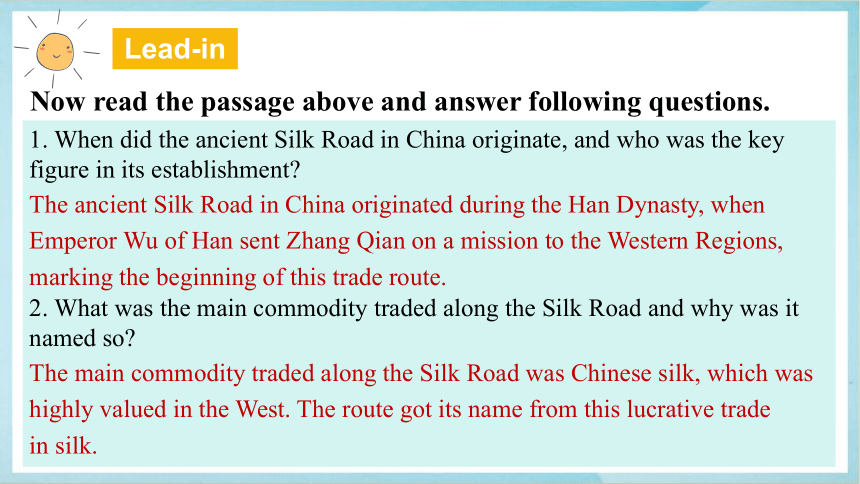

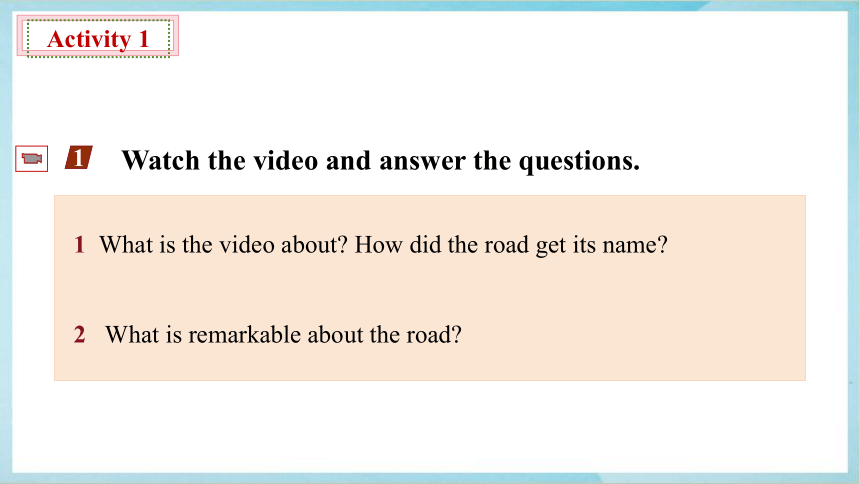

文档简介
(共22张PPT)
Unit 3 Starting out
The world meets China
世界与中国相遇
导读课件
To watch the video, understand the main idea of the video, understand the key information from the video, and master the background and knowledge related to the text.
Through the observation, understanding, thinking and discussion of pictures, I can learn to "meet" different cultures with the mentality of appreciation, learning and tolerance, and conduct preliminary thinking on the phenomenon of
"culture shock".
To understand the richness of culture, implement the theme of "China to the world", cultivate diverse perspectives and enhance cultural pride.
Learning objectives
Words and expressions
* gateway n. 通向……的门户 34
* oasis n. (沙漠中的)绿洲 34
* glorious adj. (辉煌的的 34
* boast v. (地方、机构等)自豪地拥有(好的事物) 34
* grotto n. 小洞穴 34
* testimony n. 证据;证明 35
statue n. 雕像;塑像 35
* mural n. 壁画 35
* religious adj. 宗教的 35
* Apsaras n. 飞天 35
* immortal n. 神 35
* heavenly adj. 天国的 35
peak n. 高峰,顶点 35
Taoist priest 道士 35
* scroll n. 纸卷,卷轴 35
* ceramics n. 陶瓷制品 36
* crossroads n. 活动中心,汇集地 36
* expo n. 展览会,博览会 36
strengthen v. 加强 36
coverage n. 覆盖范围 37
scholar n. 学者 39
department n. (大学的)系,部 40
institute n. 学院;研究院 40
1. Do you know where the Belt and Road Initiative originated
2. How much do you know about the ancient Silk Road
Yes, I know. The Belt and Road Initiative originated in China.
I know some basic information about it. The ancient Silk Road was an important ancient trade route connecting China with the West.
Lead-in
3. Can you tell me more about the ancient Silk Road in China
Of course. The ancient Silk Road in China originated during the Han Dynasty, when Emperor Wu of Han sent Zhang Qian on a mission to the Western Regions, opening up a path to Central Asia. This mission not only promoted exchanges between China and the countries of the Western Regions but also laid the foundation for the formation of the Silk Road.
Zhang Qian's journey was arduous. He and his companions were captured by the Xiongnu and detained for ten years. During this time, he learned about the roads to the Western Regions and the Xiongnu language, which helped them escape and continue their journey. They eventually reached countries such as Dayuan and Bactria, where Zhang Qian collected information about the "heavenly horses" (feral horses with a unique appearance) and the geography, politics, and economy of the Western Regions.
The Silk Road got its name from the trade in Chinese silk, which was highly valued in the West. Besides silk, other commodities such as tea, porcelain, spices, medicinal materials, and metal products were also traded along this route. In return, goods from the West, including wine, glassware, jewels, and spices, entered China.
The Silk Road was not just a trade route; it was also an important platform for cultural, religious, and scientific exchanges. Along this route, the arts, architectures, music, and dances of various ethnic groups influenced each other, forming a multicultural fusion. Buddhism spread from India to China through the Silk Road, and religions such as Christianity and Islam also reached China via this route. Ancient astronomy, medicine, and agricultural technology spread to different regions through the Silk Road, promoting scientific and technological progress worldwide.
In summary, the ancient Silk Road in China was a significant trade and cultural exchange route connecting China and the West, promoting economic development, cultural prosperity, and technological progress along the route.
Lead-in
Now read the passage above and answer following questions.
1. When did the ancient Silk Road in China originate, and who was the key figure in its establishment
The ancient Silk Road in China originated during the Han Dynasty, when Emperor Wu of Han sent Zhang Qian on a mission to the Western Regions, marking the beginning of this trade route.
2. What was the main commodity traded along the Silk Road and why was it named so
The main commodity traded along the Silk Road was Chinese silk, which was highly valued in the West. The route got its name from this lucrative trade
in silk.
Lead-in
Now read the passage above and answer following questions.
3. Besides trade, what other exchanges took place along the Silk Road
Besides trade, the Silk Road facilitated cultural, religious, and scientific exchanges, leading to a multicultural fusion and the spread of religions, arts, and technologies across different regions.
Lead-in
1
Watch the video and answer the questions.
1 What is the video about How did the road get its name
2 What is remarkable about the road
Activity 1
Activity 1
Activity 1
视频脚本
The Silk Road
The Silk Road was an important historical trade route between China and the Mediterranean. In the past, travel by land was difficult, dangerous and expensive, so only very valuable goods such as silk were traded over long distances. In fact, silk made in China comprised a large proportion of the trade along that route. Thus, in 1877, this route was given the name “the Silk Road”by the famous German geographer, Ferdinand von Richthofen.
The history of the old Silk Road began with the explorations of Zhang Qian during the Han Dynasty, and continued until the Ming Dynasty - a period of some 1,700 years. The route started at Chang'an, the modern Xi'an. It then passed through the Hexi Corridor, before reaching Dunhuang. From there, the Silk Road split into the northern, central, and southern routes, proceeding through today's Xinjiang Uygur Autonomous Region of China to reach India, and eventually Italy.
The Silk Road was more than just a trade route. It was a cultural crossroads that connected the great ancient civilisations of China, India, Persia, Greece, Rome and others. Between these civilisations passed new ideas, developments in the arts and new inventions, including the four great Chinese inventions: gunpowder, papermaking, printing and the compass.
Today, the old Silk Road is being brought back to life through China's Belt and Road Initiative. The new Silk Road will bring all kinds of goods to people along the route. These goods will be delivered at higher speeds and lower prices. And, more importantly, this new Silk Road will make cultural exchanges faster and easier, helping more people come together in mutual understanding and friendship.
Activity 1
视频脚本
丝绸之路
丝绸之路是历史上连接中国和地中海的一条重要贸易路线。在过去,陆路旅行既困难、危险又昂贵,所以只有丝绸这样的贵重物品才能进行长途贸易。事实上,中国制造的丝绸在这条路线上的贸易中占很大比例。因此,在1877年,这条路线被著名的德国地理学家费迪南德·冯·里希特霍芬命名为“丝绸之路”。
古丝绸之路的历史始于汉代张骞的探索,一直持续到明朝,长达1700年左右。这条路线始于长安,也就是现在的西安。然后穿过河西走廊,到达敦煌。从那里开始,丝绸之路分为北部、中部和南部路线,穿过今天的中国新疆维吾尔自治区,到达印度,最终到达意大利。
丝绸之路不仅仅是一条贸易路线。它是连接中国、印度、波斯、希腊、罗马等伟大古文明的文化十字路口。这些文明之间传递着新的思想、艺术的发展和新的发明,包括中国的四大发明:火药、造纸术、印刷术和指南针。
今天,通过中国的“一带一路”倡议,古老的丝绸之路重新焕发了生机。新丝绸之路将为沿途的人们带来各种各样的商品。这些货物将以更快的速度和更低的价格交付。更重要的是,这条新丝绸之路将使文化交流更快、更容易,让更多的人走到一起,相互了解,增进友谊。
1
Watch the video and answer the questions.
1 What is the video about How did the road get its name
2 What is remarkable about the road
The video is about the historical importance of the ancient Silk Road and its revival through the Belt and Road initiative.
It got its name because a lot of trade along the road was in Chinese silk.
The road is remarkable firstly because it lasted around 1700 years from the Han Dynasty until the Ming Dynasty. Secondly, it’s a unique and important cultural crossroads between the East and West.
Activity 1
2
Look at the pictures and answer the questions.
Activity 2
1
2
3
4
2
Look at the pictures and answer the questions.
1 What can you see in these pictures
Activity 2
The picture shows Chinese and foreign students are walking through their school.
It shows Chinese and foreigners are doing body-building exercise eg. tai chi, a traditional Chinese sport.
1
2
These pictures show Chinese and foreigners are studying, exercising and doing business together, and a group of foreign tourists are exploring China.
2
Look at the pictures and answer the questions.
1 What can you see in these pictures
Activity 2
A group of foreign tourists are exploring the Great Wall of China.
The picture shows a foreign business man is shaking hands with a Chinese one.
3
4
2
Look at the pictures and answer the questions.
2 What message do these pictures convey
Activity 2
a. Overseas students come to China to study.
b. Foreigners are learning about traditional Chinese culture.
c. Foreign tourists are interested in travelling to China to explore its
famous heritage sites.
d. Business is being done between Chinese and overseas companies.
2
Look at the pictures and answer the questions.
3 In what other areas is China attracting attention around the world
Activity 2
Manufacturing industry, infrastructure construction, communication, China's High Speed Rail (HSR).
With the rapid development of China in recent years, China is attracting the world's attention in many aspects such as AI technology, quantum information(量子信息), 5G and 6G communications, semiconductor and chip design, renewable energy, satellite navigation, as well as high-speed rail and aerospace technology.
Activity 2
Please enjoy the following passage and answer the questions.
The world meets China through various channels and platforms, experiencing its rich culture, rapid economic development, technological innovations, and significant global impact. China, with its long history and diverse traditions, offers a fascinating blend of ancient wisdom and modern progress.
Economically, China has become a key player in the global market, driving growth and collaboration in numerous industries. Its technological advancements, particularly in areas like artificial intelligence, 5G, and renewable energy, are shaping the future of many sectors.
Culturally, China's art, music, cuisine, and festivals captivate people around the world, fostering understanding and appreciation for its unique heritage. The country's tourism industry also showcases its stunning landscapes and architectural marvels.
Additionally, China's role in global governance and international cooperation is increasingly prominent, as it contributes to solving global challenges and promoting sustainable development.
On the whole, the world meets China as a dynamic and influential nation that combines tradition with innovation, offering opportunities for collaboration and mutual learning.
世界通过各种渠道和平台了解中国,体验中国丰富的文化、快速的经济发展、科技创新和重大的全球影响。中国有着悠久的历史和多元的传统,是古代智慧和现代进步的完美结合。
在经济上,中国已成为全球市场的关键参与者,推动了众多行业的增长和合作。中国的技术进步,特别是在人工智能、5G和可再生能源等领域,正在塑造许多行业的未来。
在文化上,中国的艺术、音乐、美食和节日吸引了世界各地的人们,促进了对其独特遗产的理解和欣赏。该国的旅游业也展示了其令人惊叹的景观和建筑奇迹。
此外,中国在全球治理和国际合作中的作用日益突出,为解决全球性挑战、促进可持续发展作出了贡献。
总的来说,世界看到的中国是一个充满活力和影响力的国家,传统与创新相结合,提供了合作和相互学习的机会。
Activity 2
1. What are the main aspects through which the world encounters China
The main aspects are its rich culture, rapid economic development, technological innovations, and significant global impact.
2. In which technological areas is China making significant advancements
China is making significant advancements in areas like artificial intelligence, 5G, and renewable energy.
Activity 2
3. How does China's cultural heritage captivate people worldwide
China's cultural heritage captivates people worldwide through its art, music, cuisine, and festivals, fostering understanding and appreciation for its
unique traditions.
4. What role does China play in global governance and
international cooperation
China plays an increasingly prominent role in global governance and international cooperation, contributing to solving global challenges and promoting sustainable development.
Search the Internet for Dunhuang's important position on the Silk Road, please write an introduction in simple English, no more than 120 words.
Homework
Dunhuang, in the Hexi Corridor, is a key city on the Silk Road. It's a vital gateway for trade and cultural exchange between East and West. Here, silk, porcelain, and other goods were traded, and diverse religions and cultures mixed. The Mogao Grottoes, a World Heritage site, show its rich history and culture.
As a key node on the Silk Road, Dunhuang facilitated the trade of silk, porcelain, and other commodities, and was a melting pot of various religions and cultures. The famous Mogao Grottoes, a UNESCO World Heritage site, further testament to its rich historical and cultural heritage.
Sample
Unit 3 Starting out
The world meets China
世界与中国相遇
导读课件
To watch the video, understand the main idea of the video, understand the key information from the video, and master the background and knowledge related to the text.
Through the observation, understanding, thinking and discussion of pictures, I can learn to "meet" different cultures with the mentality of appreciation, learning and tolerance, and conduct preliminary thinking on the phenomenon of
"culture shock".
To understand the richness of culture, implement the theme of "China to the world", cultivate diverse perspectives and enhance cultural pride.
Learning objectives
Words and expressions
* gateway n. 通向……的门户 34
* oasis n. (沙漠中的)绿洲 34
* glorious adj. (辉煌的的 34
* boast v. (地方、机构等)自豪地拥有(好的事物) 34
* grotto n. 小洞穴 34
* testimony n. 证据;证明 35
statue n. 雕像;塑像 35
* mural n. 壁画 35
* religious adj. 宗教的 35
* Apsaras n. 飞天 35
* immortal n. 神 35
* heavenly adj. 天国的 35
peak n. 高峰,顶点 35
Taoist priest 道士 35
* scroll n. 纸卷,卷轴 35
* ceramics n. 陶瓷制品 36
* crossroads n. 活动中心,汇集地 36
* expo n. 展览会,博览会 36
strengthen v. 加强 36
coverage n. 覆盖范围 37
scholar n. 学者 39
department n. (大学的)系,部 40
institute n. 学院;研究院 40
1. Do you know where the Belt and Road Initiative originated
2. How much do you know about the ancient Silk Road
Yes, I know. The Belt and Road Initiative originated in China.
I know some basic information about it. The ancient Silk Road was an important ancient trade route connecting China with the West.
Lead-in
3. Can you tell me more about the ancient Silk Road in China
Of course. The ancient Silk Road in China originated during the Han Dynasty, when Emperor Wu of Han sent Zhang Qian on a mission to the Western Regions, opening up a path to Central Asia. This mission not only promoted exchanges between China and the countries of the Western Regions but also laid the foundation for the formation of the Silk Road.
Zhang Qian's journey was arduous. He and his companions were captured by the Xiongnu and detained for ten years. During this time, he learned about the roads to the Western Regions and the Xiongnu language, which helped them escape and continue their journey. They eventually reached countries such as Dayuan and Bactria, where Zhang Qian collected information about the "heavenly horses" (feral horses with a unique appearance) and the geography, politics, and economy of the Western Regions.
The Silk Road got its name from the trade in Chinese silk, which was highly valued in the West. Besides silk, other commodities such as tea, porcelain, spices, medicinal materials, and metal products were also traded along this route. In return, goods from the West, including wine, glassware, jewels, and spices, entered China.
The Silk Road was not just a trade route; it was also an important platform for cultural, religious, and scientific exchanges. Along this route, the arts, architectures, music, and dances of various ethnic groups influenced each other, forming a multicultural fusion. Buddhism spread from India to China through the Silk Road, and religions such as Christianity and Islam also reached China via this route. Ancient astronomy, medicine, and agricultural technology spread to different regions through the Silk Road, promoting scientific and technological progress worldwide.
In summary, the ancient Silk Road in China was a significant trade and cultural exchange route connecting China and the West, promoting economic development, cultural prosperity, and technological progress along the route.
Lead-in
Now read the passage above and answer following questions.
1. When did the ancient Silk Road in China originate, and who was the key figure in its establishment
The ancient Silk Road in China originated during the Han Dynasty, when Emperor Wu of Han sent Zhang Qian on a mission to the Western Regions, marking the beginning of this trade route.
2. What was the main commodity traded along the Silk Road and why was it named so
The main commodity traded along the Silk Road was Chinese silk, which was highly valued in the West. The route got its name from this lucrative trade
in silk.
Lead-in
Now read the passage above and answer following questions.
3. Besides trade, what other exchanges took place along the Silk Road
Besides trade, the Silk Road facilitated cultural, religious, and scientific exchanges, leading to a multicultural fusion and the spread of religions, arts, and technologies across different regions.
Lead-in
1
Watch the video and answer the questions.
1 What is the video about How did the road get its name
2 What is remarkable about the road
Activity 1
Activity 1
Activity 1
视频脚本
The Silk Road
The Silk Road was an important historical trade route between China and the Mediterranean. In the past, travel by land was difficult, dangerous and expensive, so only very valuable goods such as silk were traded over long distances. In fact, silk made in China comprised a large proportion of the trade along that route. Thus, in 1877, this route was given the name “the Silk Road”by the famous German geographer, Ferdinand von Richthofen.
The history of the old Silk Road began with the explorations of Zhang Qian during the Han Dynasty, and continued until the Ming Dynasty - a period of some 1,700 years. The route started at Chang'an, the modern Xi'an. It then passed through the Hexi Corridor, before reaching Dunhuang. From there, the Silk Road split into the northern, central, and southern routes, proceeding through today's Xinjiang Uygur Autonomous Region of China to reach India, and eventually Italy.
The Silk Road was more than just a trade route. It was a cultural crossroads that connected the great ancient civilisations of China, India, Persia, Greece, Rome and others. Between these civilisations passed new ideas, developments in the arts and new inventions, including the four great Chinese inventions: gunpowder, papermaking, printing and the compass.
Today, the old Silk Road is being brought back to life through China's Belt and Road Initiative. The new Silk Road will bring all kinds of goods to people along the route. These goods will be delivered at higher speeds and lower prices. And, more importantly, this new Silk Road will make cultural exchanges faster and easier, helping more people come together in mutual understanding and friendship.
Activity 1
视频脚本
丝绸之路
丝绸之路是历史上连接中国和地中海的一条重要贸易路线。在过去,陆路旅行既困难、危险又昂贵,所以只有丝绸这样的贵重物品才能进行长途贸易。事实上,中国制造的丝绸在这条路线上的贸易中占很大比例。因此,在1877年,这条路线被著名的德国地理学家费迪南德·冯·里希特霍芬命名为“丝绸之路”。
古丝绸之路的历史始于汉代张骞的探索,一直持续到明朝,长达1700年左右。这条路线始于长安,也就是现在的西安。然后穿过河西走廊,到达敦煌。从那里开始,丝绸之路分为北部、中部和南部路线,穿过今天的中国新疆维吾尔自治区,到达印度,最终到达意大利。
丝绸之路不仅仅是一条贸易路线。它是连接中国、印度、波斯、希腊、罗马等伟大古文明的文化十字路口。这些文明之间传递着新的思想、艺术的发展和新的发明,包括中国的四大发明:火药、造纸术、印刷术和指南针。
今天,通过中国的“一带一路”倡议,古老的丝绸之路重新焕发了生机。新丝绸之路将为沿途的人们带来各种各样的商品。这些货物将以更快的速度和更低的价格交付。更重要的是,这条新丝绸之路将使文化交流更快、更容易,让更多的人走到一起,相互了解,增进友谊。
1
Watch the video and answer the questions.
1 What is the video about How did the road get its name
2 What is remarkable about the road
The video is about the historical importance of the ancient Silk Road and its revival through the Belt and Road initiative.
It got its name because a lot of trade along the road was in Chinese silk.
The road is remarkable firstly because it lasted around 1700 years from the Han Dynasty until the Ming Dynasty. Secondly, it’s a unique and important cultural crossroads between the East and West.
Activity 1
2
Look at the pictures and answer the questions.
Activity 2
1
2
3
4
2
Look at the pictures and answer the questions.
1 What can you see in these pictures
Activity 2
The picture shows Chinese and foreign students are walking through their school.
It shows Chinese and foreigners are doing body-building exercise eg. tai chi, a traditional Chinese sport.
1
2
These pictures show Chinese and foreigners are studying, exercising and doing business together, and a group of foreign tourists are exploring China.
2
Look at the pictures and answer the questions.
1 What can you see in these pictures
Activity 2
A group of foreign tourists are exploring the Great Wall of China.
The picture shows a foreign business man is shaking hands with a Chinese one.
3
4
2
Look at the pictures and answer the questions.
2 What message do these pictures convey
Activity 2
a. Overseas students come to China to study.
b. Foreigners are learning about traditional Chinese culture.
c. Foreign tourists are interested in travelling to China to explore its
famous heritage sites.
d. Business is being done between Chinese and overseas companies.
2
Look at the pictures and answer the questions.
3 In what other areas is China attracting attention around the world
Activity 2
Manufacturing industry, infrastructure construction, communication, China's High Speed Rail (HSR).
With the rapid development of China in recent years, China is attracting the world's attention in many aspects such as AI technology, quantum information(量子信息), 5G and 6G communications, semiconductor and chip design, renewable energy, satellite navigation, as well as high-speed rail and aerospace technology.
Activity 2
Please enjoy the following passage and answer the questions.
The world meets China through various channels and platforms, experiencing its rich culture, rapid economic development, technological innovations, and significant global impact. China, with its long history and diverse traditions, offers a fascinating blend of ancient wisdom and modern progress.
Economically, China has become a key player in the global market, driving growth and collaboration in numerous industries. Its technological advancements, particularly in areas like artificial intelligence, 5G, and renewable energy, are shaping the future of many sectors.
Culturally, China's art, music, cuisine, and festivals captivate people around the world, fostering understanding and appreciation for its unique heritage. The country's tourism industry also showcases its stunning landscapes and architectural marvels.
Additionally, China's role in global governance and international cooperation is increasingly prominent, as it contributes to solving global challenges and promoting sustainable development.
On the whole, the world meets China as a dynamic and influential nation that combines tradition with innovation, offering opportunities for collaboration and mutual learning.
世界通过各种渠道和平台了解中国,体验中国丰富的文化、快速的经济发展、科技创新和重大的全球影响。中国有着悠久的历史和多元的传统,是古代智慧和现代进步的完美结合。
在经济上,中国已成为全球市场的关键参与者,推动了众多行业的增长和合作。中国的技术进步,特别是在人工智能、5G和可再生能源等领域,正在塑造许多行业的未来。
在文化上,中国的艺术、音乐、美食和节日吸引了世界各地的人们,促进了对其独特遗产的理解和欣赏。该国的旅游业也展示了其令人惊叹的景观和建筑奇迹。
此外,中国在全球治理和国际合作中的作用日益突出,为解决全球性挑战、促进可持续发展作出了贡献。
总的来说,世界看到的中国是一个充满活力和影响力的国家,传统与创新相结合,提供了合作和相互学习的机会。
Activity 2
1. What are the main aspects through which the world encounters China
The main aspects are its rich culture, rapid economic development, technological innovations, and significant global impact.
2. In which technological areas is China making significant advancements
China is making significant advancements in areas like artificial intelligence, 5G, and renewable energy.
Activity 2
3. How does China's cultural heritage captivate people worldwide
China's cultural heritage captivates people worldwide through its art, music, cuisine, and festivals, fostering understanding and appreciation for its
unique traditions.
4. What role does China play in global governance and
international cooperation
China plays an increasingly prominent role in global governance and international cooperation, contributing to solving global challenges and promoting sustainable development.
Search the Internet for Dunhuang's important position on the Silk Road, please write an introduction in simple English, no more than 120 words.
Homework
Dunhuang, in the Hexi Corridor, is a key city on the Silk Road. It's a vital gateway for trade and cultural exchange between East and West. Here, silk, porcelain, and other goods were traded, and diverse religions and cultures mixed. The Mogao Grottoes, a World Heritage site, show its rich history and culture.
As a key node on the Silk Road, Dunhuang facilitated the trade of silk, porcelain, and other commodities, and was a melting pot of various religions and cultures. The famous Mogao Grottoes, a UNESCO World Heritage site, further testament to its rich historical and cultural heritage.
Sample
